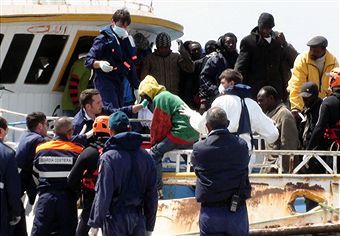 A human wave of refugees is supposedly setting off for Europe from North Africa. But
what are the real figures? The first thing to note that refugees from North Africa come at a time when there has been a sharp decrease in the number of asylum applicants in the 27 EU member-states.
Eurostat says that in 1992 there were 670,000 applications in the EU-15 and in 2001 there were 424,500 applications in the expanded EU-27. But according to the UN, the 27 EU member-states
registered only 247,300 asylum claims in 2009 and 235,900 in 2010, a 5 per cent annual decrease. Within this group, the 15 ‘old’ EU member-states saw no significant change in the number
of applicants during the last couple of years, while the 12 ‘new’ member-states registered 9,600 fewer claims, a drop of 38 per cent.
A human wave of refugees is supposedly setting off for Europe from North Africa. But
what are the real figures? The first thing to note that refugees from North Africa come at a time when there has been a sharp decrease in the number of asylum applicants in the 27 EU member-states.
Eurostat says that in 1992 there were 670,000 applications in the EU-15 and in 2001 there were 424,500 applications in the expanded EU-27. But according to the UN, the 27 EU member-states
registered only 247,300 asylum claims in 2009 and 235,900 in 2010, a 5 per cent annual decrease. Within this group, the 15 ‘old’ EU member-states saw no significant change in the number
of applicants during the last couple of years, while the 12 ‘new’ member-states registered 9,600 fewer claims, a drop of 38 per cent.
Britain alone was the sixth largest recipient of new asylum seekers in 2010, with 22,100 claims. But this was the lowest level since 1989. Compared to 2009, this represents a 28 per cent drop. The figure confirms a trend line between 2006 and 2010, which saw Britain receive a smaller share of asylum-seekers out of the global number of applications. In 2006 the figure was 9 per cent; in 2010 it was down to 6 per cent. By comparison, Sweden – a country seven times less populated than Britain – took three per cent more of the total number of applicants worldwide.
Immigration is a different matter, but the numbers of migrants coming into Europe are also decreasing. According to Eurostat figures, in 2008 about 3.8 million people immigrated into one of the EU member-states and at least 2.3 million emigrants are reported to have left one of the states. Compared with 2007, immigration to EU member-states is estimated to have decreased by 6 per cent and emigration to have increased by 13 per cent. These statistics are three years old, but there is no sign of a massive change. In Britain, the Home Office reports that the number of persons granted British citizenship fell by 1 per cent compared to last year.
Finally, how many refugees have come to Europe in 2011 so far? Up-to-date data is hard to come by for all of Europe, but the Home Office estimates that including dependants, the number of asylum applications to the EU-27 countries increased by 1 per cent in the first quarter of 2011 (58,300) compared with the first quarter of 2010 (57,600). The number of applications for asylum in Britain, excluding dependants, in turn was 11 per cent higher than the first quarter of 2011 (4,845) compared with the same period last year (4,355). This represents the first quarter since 2009 for which the number of applications is higher than a year earlier. But it remains a very small percentage of the world’s refugees.
Numbers only mean so much. It is perfectly understandable to be concerned about refugees and migrants and their impact on local communities, even if the actual numbers of people are limited. But given the rhetoric of the likes of Silvio Berlusconi and the talk of “waves” of refugees setting off from North Africa, it is worth reminding oneself that across Europe, the number of refugees and migrants has decreased over many years; and while Britain experienced an early increase in early 2011, it is too early to say whether this will be sustained.






Comments